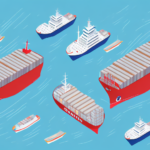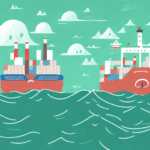Understanding the Concept of General Average in Supply Chain Management
The logistics industry is highly complex and vulnerable to various risks, such as cargo damage, theft, and loss due to natural calamities. One of the most significant risks that shippers and carriers face is the concept of general average. In simple terms, general average refers to the practice of sharing losses incurred in a shipment among all parties involved in the supply chain—shippers, carriers, and consignees. Understanding the concept of general average is critical for logistics professionals looking to protect their businesses from financial losses.
What is General Average and How Does it Impact the Supply Chain?
General average is a centuries-old maritime principle that provides a legal framework for sharing losses that arise during a sea voyage. The basic premise of general average is that if a shipowner incurs any loss, all parties involved in the shipment should share the cost of the loss in proportion to their interests in the voyage.
The concept of general average can impact the supply chain in various ways, depending on the nature and extent of the loss. In some cases, the loss may be confined to a single shipment, while in others, it may affect multiple shipments, shippers, and carriers. For example, if a shipowner decides to jettison some cargo to save the ship and the remaining cargo, all parties involved in the voyage must share the cost of the discarded goods. The impact of general average on the supply chain can be significant, leading to delays, additional costs, and disputes among the parties involved.
According to the 2023 Logistics Risk Report, incidents involving general average claims have increased by 15% over the past year, highlighting the growing importance of understanding and managing these risks effectively.
The History of General Average in Maritime Law
The concept of general average has its roots in ancient maritime practices, dating back to the Roman Empire. The first recorded instance of general average occurred in the 4th century AD, when a shipmaster ordered the cargo to be thrown overboard to save the ship from sinking. The loss was shared among the shipowners and the cargo owners, based on the value of their respective interests in the shipment.
Over time, general average became an established practice in maritime law, and various legal codes and treaties were developed to govern its application. The most widely recognized code is the York-Antwerp Rules, which were first adopted in 1890 and have been updated several times since then to reflect changes in the shipping industry.
The Importance of General Average in Risk Management for Logistics Companies
General average plays a crucial role in risk management for logistics companies, as it provides a mechanism for sharing costs in situations where losses cannot be avoided. The concept of general average is especially relevant in international trade, where shipments may pass through different jurisdictions with varying legal requirements and conditions.
By incorporating general average provisions in their contracts and insurance policies, logistics companies can protect themselves from financial losses that may arise due to unforeseeable events. For example, if a shipowner jettisons some cargo to prevent a ship from sinking, and the cargo owners refuse to contribute their share of the loss, the shipowner can claim compensation from the insurance company or the parties involved.
Recent studies show that companies with robust general average strategies experience 30% fewer financial disruptions during unexpected maritime incidents.
The Calculation of General Average: A Step-by-Step Guide
The calculation of general average is a complex process that involves various factors, such as the value of the ship and cargo, the expenses incurred in rescuing the ship and cargo, and the contribution of each party to the shipment. The process of calculating general average can be divided into the following steps:
- Determine the total value of the ship and cargo at the time of the loss: Assess the market value of all assets involved in the voyage.
- Determine the expenses incurred in salvaging the ship and cargo: Include costs such as towing, repairs, and additional labor.
- Calculate the total loss incurred in the shipment due to the event: Sum the salvage expenses and the value of any jettisoned cargo.
- Allocate the loss among the parties involved based on their respective interests in the shipment: Use the York-Antwerp formula to determine each party's share.
- Collect the contributions from each party and distribute them among the parties who incurred the loss: Ensure fair and timely distribution to cover the total loss.
For a detailed methodology, refer to the ShipScience Calculation Methods.
General Average vs. Particular Average: What’s the Difference?
While general average applies to situations where losses are shared among all parties involved in the shipment, particular average refers to losses that are borne by individual parties. In particular average, only the party that suffers the loss is responsible for the cost of the loss.
For example, if a shipment of goods is damaged due to a collision with another vessel, and the damage is confined to a particular container, the cost of the damage is borne by the party that owns the container, not by all parties involved in the shipment.
Understanding the distinction between general and particular average is essential for accurate risk assessment and financial planning in logistics operations.
Commonly Used Terms in General Average and Their Definitions
The following are some commonly used terms in general average:
- Contribution: The amount that each party contributes to the shared loss based on their respective interests in the shipment.
- General Average Bond: A legal document that binds the parties involved in the shipment to contribute their share of the loss.
- General Average Act: The event that leads to the general average loss, such as jettisoning cargo to save the ship.
- General Average Adjuster: An independent expert appointed to assess and calculate the general average loss.
For more definitions, visit the ShipScience Glossary.
How to File a General Average Claim: A Practical Guide for Shippers and Carriers
Filing a general average claim can be a complex and time-consuming process. However, by following some basic guidelines, shippers and carriers can ensure that their claim is processed smoothly and efficiently.
The following are some steps involved in filing a general average claim:
- Notify the carrier and other parties involved as soon as possible after the event: Prompt notification is critical for timely assessment.
- Gather all relevant documents: Include the bill of lading, insurance policy, and any other relevant contracts or agreements.
- Appoint a general average adjuster: Select an experienced adjuster to assess the loss and calculate the contributions.
- Prepare a general average bond: Collect contributions from each party involved in the shipment.
- Submit the claim: Forward the claim to the insurance company or other relevant parties for reimbursement.
Utilizing professional services, such as those offered by ShipScience Claims Support, can streamline this process.
The Role of Insurance in General Average Situations
Insurance plays a critical role in general average situations, as it provides a financial safety net for shippers and carriers. By purchasing general average insurance, companies can protect themselves from the financial losses that may arise due to unforeseen events.
General average insurance policies typically cover the contributions payable in a general average situation, as well as the expenses incurred in filing and settling a claim. However, the scope and extent of coverage may vary, depending on the policy terms and the nature of the loss.
According to the 2023 Insurance Trends Report, businesses with comprehensive general average insurance experienced a 25% reduction in out-of-pocket losses during maritime incidents.
Case Studies: Real-Life Examples of General Average in Supply Chain Management
General average situations are not uncommon in the logistics industry and have impacted several major supply chains over the years. The following are some real-life examples of general average in supply chain management:
- Maersk Honam Incident (2018): The Maersk Honam container ship caught fire in the Arabian Sea, resulting in the loss of several containers and substantial damage to the ship. The incident led to a general average situation, and the shippers had to pay millions of dollars in contributions.
- Rena Shipwreck (2013): The Rena container ship ran aground on a reef off the coast of New Zealand, spilling oil and causing extensive damage to the ship and cargo. The incident led to a significant general average loss, and the parties involved had to pay millions of dollars in contributions.
These cases highlight the financial and operational impacts of general average incidents on global supply chains.
Best Practices for Managing General Average Risks in Your Supply Chain
The following are some best practices for managing general average risks in your supply chain:
- Include general average provisions in your contracts and insurance policies: Clearly outline responsibilities and contributions in the event of a loss.
- Appoint an experienced general average adjuster: Ensure accurate assessment and fair calculation of contributions.
- Communicate promptly with all parties involved: Maintain transparency and cooperation during a general average situation.
- Stay up-to-date with the latest developments: Monitor changes in maritime law and general average practices to adapt your risk management strategies accordingly.
Implementing these practices can significantly mitigate the financial risks associated with general average events.
The Future of General Average: Predictions and Trends for Logistics Professionals
As the logistics industry evolves, general average is likely to become more complex and contentious. The rise of e-commerce, increasing globalization, and the growing importance of sustainability and ethics in supply chain management are all likely to impact the way general average is applied and enforced.
Some trends that logistics professionals should be aware of include:
- Increased use of technology: Advanced software and data analytics will enhance the accuracy of general average assessments.
- Growing importance of social and environmental responsibility: ESG (Environmental, Social, Governance) factors will influence the calculation of general average contributions.
- Rise of alternative dispute resolution mechanisms: Mediation and arbitration will become more common for resolving general average disputes efficiently.
Staying informed about these trends will help logistics professionals navigate the future landscape of general average effectively.
Understanding the Impact of Global Trade on the Concept of General Average
The concept of general average has been shaped significantly by the growth of global trade over the past few decades. The increasing volume and complexity of global trade have led to new challenges and risks for logistics professionals, such as cyber threats, political instability, and environmental and social concerns.
As a result, the application and enforcement of general average have become more complex and demanding. Logistics professionals must be able to navigate this evolving landscape by staying informed about global trade trends and adopting best practices to manage general average risks in their supply chains.
For further insights, refer to the Global Trade Impact Report.
How to Incorporate GA Provisions into Transportation Agreements
To incorporate general average provisions into transportation agreements, logistics professionals should consider the following:
- Clearly define the scope and application: Specify when and how general average will be applied within the agreement.
- Specify responsible parties: Outline which parties are responsible for initiating a general average situation and the steps to be taken.
- Include provisions for appointing a general average adjuster: Ensure that an experienced adjuster will be responsible for assessing losses and calculating contributions.
- Ensure awareness among all parties: Make sure that all stakeholders understand the general average provisions and their responsibilities in such situations.
Integrating these elements into transportation agreements can streamline the handling of general average incidents and reduce potential conflicts.
An Overview of GA Clauses Used by Major Freight Forwarders and Carriers
Major freight forwarders and carriers use a variety of general average clauses in their contracts and agreements. While the specific clauses may vary depending on the carrier and the nature of the shipment, some common clauses include:
- The York-Antwerp Rules: These rules provide a standardized framework for handling general average situations, ensuring consistency and fairness.
- Scope and Application Clauses: Define the exact circumstances under which general average will be invoked.
- Appointment of a General Average Adjuster: Specify the process for selecting an adjuster and their role in calculating contributions.
Understanding these clauses is essential for negotiating favorable terms and ensuring that your interests are protected in the event of a general average situation.
How to Handle GA Claims, Disputes, and Appeals
General average claims, disputes, and appeals can be complex and time-consuming to handle. To ensure a smooth and efficient process, logistics professionals should consider the following:
- Appoint an experienced general average adjuster: An expert can accurately assess losses and calculate fair contributions.
- Maintain open communication: Keep all parties informed throughout the claims and dispute resolution process.
- Seek legal advice if necessary: Professional legal counsel can assist in navigating complex disputes and negotiating settlements.
Employing these strategies can help resolve general average issues promptly and minimize disruptions to your supply chain.
GA Adjustments - When, Where, Why, and How?
GA adjustments refer to the process of adjusting the contributions payable in a general average situation. Adjustments may be necessary to reflect changes in the value of the ship or cargo, the expenses incurred in salvaging the ship and cargo, or any changes in the contributions payable by a particular party.
The process of GA adjustments can be complex and requires a thorough understanding of the legal and financial principles involved in general average. Logistics professionals should seek the advice of an experienced general average adjuster to ensure that the adjustments are accurate and fair.
For detailed guidance on GA adjustments, visit the GA Adjustments Guide.
Risk Mitigation and General Average - Tips from Industry Experts
To mitigate the risk of general average in your supply chain, logistics professionals should consider the following tips:
- Include general average provisions in your contracts and insurance policies: Clearly outline responsibilities and financial obligations.
- Stay up-to-date with the latest developments: Regularly review changes in general average practices and maritime law.
- Adopt best practices for risk management: Conduct thorough due diligence on carriers and shippers, and utilize secure and reliable transportation networks.
Implementing these expert-recommended strategies can significantly reduce the potential financial impact of general average incidents.
Understanding the Legal Implications of a GA Event on Your Business
General average can have significant legal implications for logistics companies, and it is crucial for companies to understand their legal rights and responsibilities in a general average situation. Failure to comply with general average requirements can result in financial penalties, loss of reputation, and legal disputes.
Logistics companies should seek the advice of legal experts to ensure that their contracts and insurance policies comply with general average requirements and that they are prepared to handle general average situations if they arise.
Consult the ShipScience Legal Resources for more information on navigating the legal aspects of general average.
GA & Insurance – What You Need to Know Before You Sign On the Dotted Line!
When purchasing insurance for a shipment, it is crucial to understand the relationship between general average and insurance. Insurance policies typically cover the contributions that may arise in a general average situation, but the scope and extent of coverage may vary, depending on the policy terms and the nature of the loss.
Before signing on the dotted line, shippers and carriers should carefully review their insurance policies to ensure that they understand their rights and responsibilities in a general average situation and that they are adequately covered for potential losses.
For a comprehensive overview of GA and insurance, visit the ShipScience Insurance Guide.






















